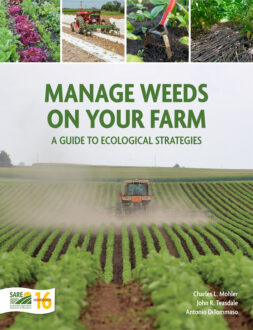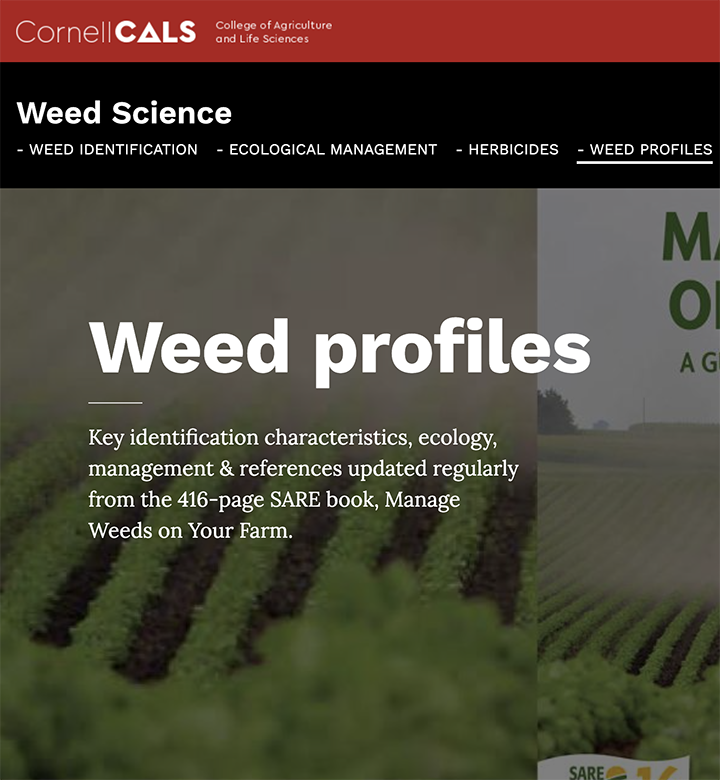Other common names: ball nettle, bull nettle, apple-of-Sodom, wild tomato, sand brier, devil’s tomato, devil’s potato, Carolina horse nettle
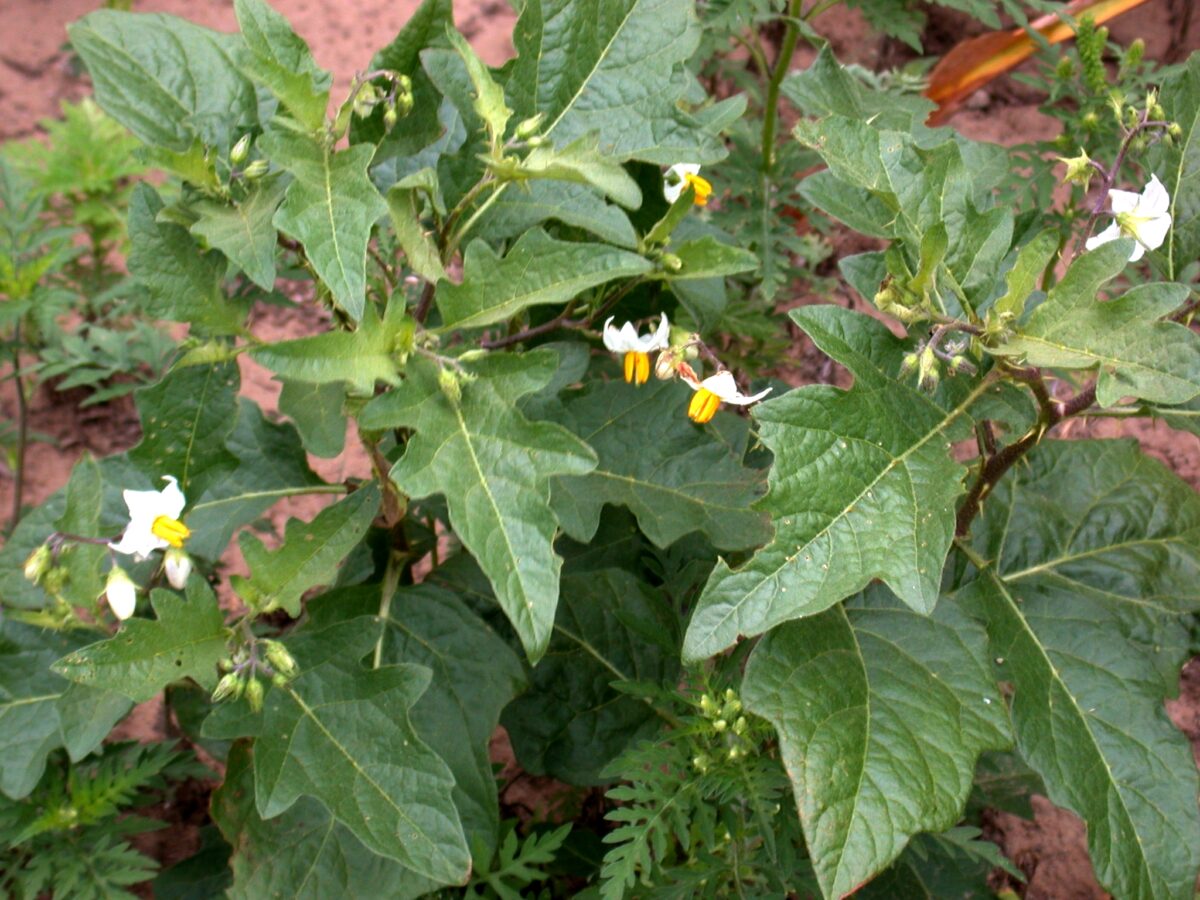
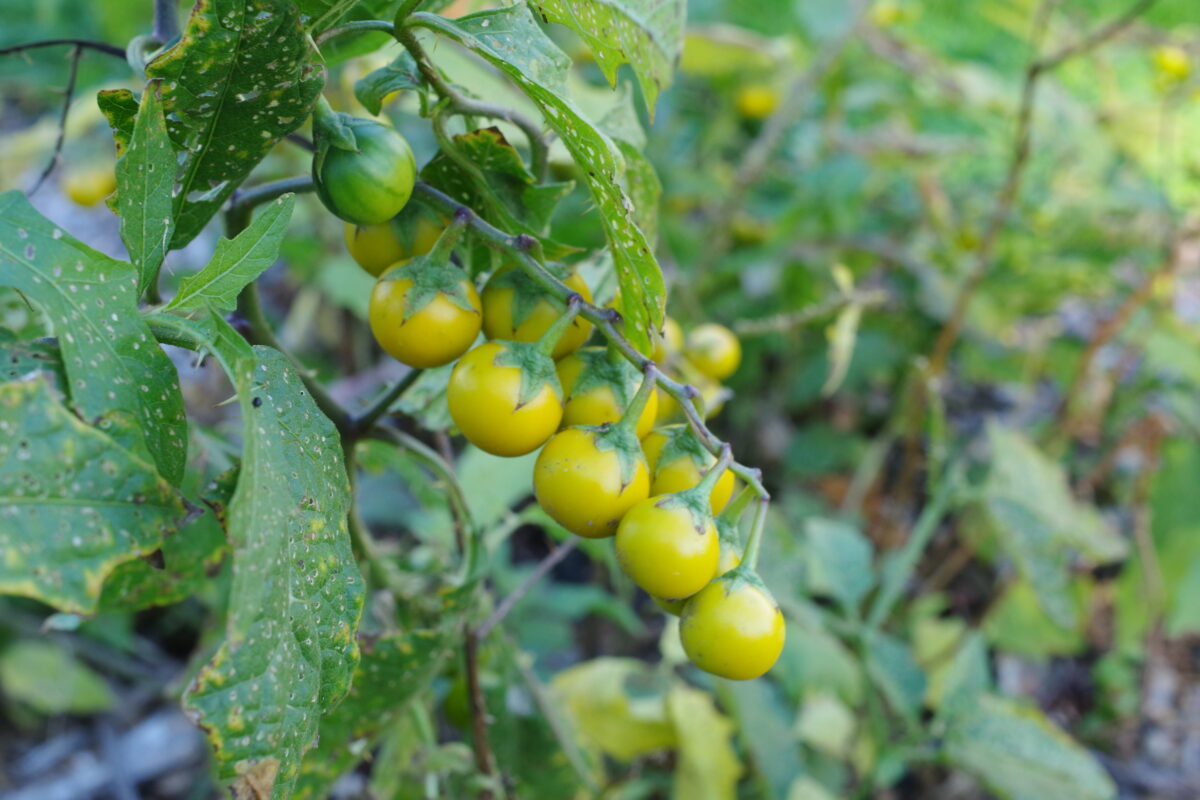
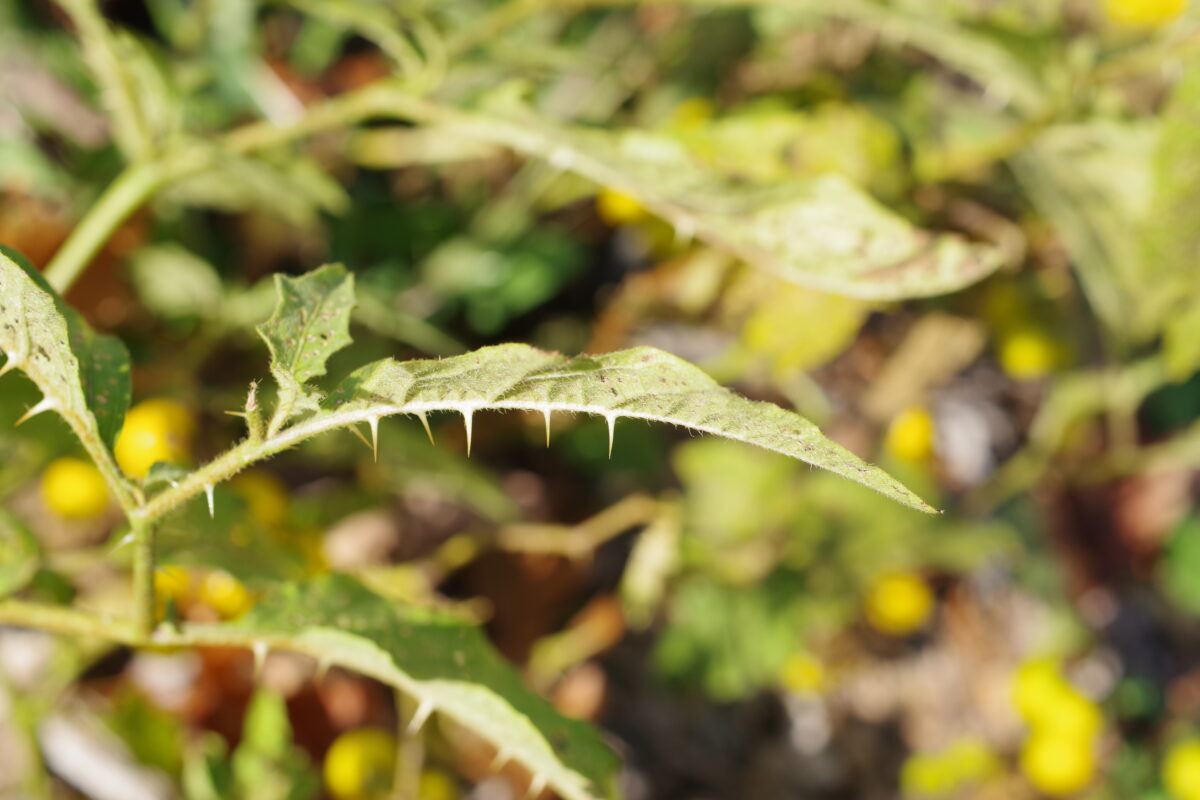
Solanum carolinense L.
Identification of Horsenettle
Family: Nightshade family, Solanaceae
Habit: Thorny, branched perennial herb spreading by deep horizontal roots
Description: Seedlings have oval to oblong-shaped, 0.5 inch-long cotyledons. The cotyledons have a shiny green surface, light green undersides and hairy margins. The stem of the seedling is purplish and has short, stiff hairs. The first pair of true leaves has untoothed, smooth edges and scattered, star shaped hairs on its upper surface. Later young leaves have wavy, lobed edges, star-shaped hairs and sharp, stiff, curved prickles on both surfaces. Mature plants arise from thick, deep, horizontal storage roots. In deep, well-drained soil, horsenettle roots can penetrate to 8 feet. Semi-woody stems with prickly hairs reach 1–3 feet. Stems are erect, angled at leaf nodes and branch moderately. Leaves are alternate and 2.5–4.5 inches long by 1–3 inches wide; they have an egg-shaped outline with two to five shallow lobes on each edge. Star shaped hairs are present on the stems and on both leaf surfaces. Large, 0.25–0.5 inch, sturdy, yellow or white, curved, painful spines and prickles are present on stems, leaf stalks, leaf veins and flower stalks. Small clusters of one to five, white to purple, potato-like flowers sit atop long, sturdy, leafless stalks. Flowers are star shaped with a central cone of yellow, pollen filled anthers. Five hairy green sepals occur at the base of the five fused, 0.75–1 inch-diameter flower petals. Immature, green berry fruits turn yellow and shrivel as they mature; mature berries are 0.5–0.75 inch across and hold 40–170 flat, round seeds. Seeds are 0.1 inch across, smooth, shiny, and range from pale to dark yellow or orange.
Similar species: Buffalobur (Solanum rostratum Dunal) cotyledons have a clear central vein when viewed from below, and young leaves have deep, round lobes that indent nearly to the midvein. Clammy groundcherry (Physalis heterophylla Nees) has densely hairy stems, single yellow or greenish flowers arising in leaf-stem junctures and berries covered in a thin, papery membrane; it does not have prickly or spiny leaves.
Management of Horsenettle
Summer tillage is a key management strategy. Since the species emerges relatively late, it is likely to increase during a sequence of spring planted, long season crops like corn and soybeans. On grain farms, rotation into a small grain crop allows midseason tillage following harvest. If possible, allow the plants to resprout and then till again before planting a winter grain or fall cover crop. This will not eliminate the weed but will reduce density. On vegetable farms, a series of short season crops, for example spring spinach, summer lettuce and a fall brassica, allows for repeated tillage during times when horsenettle is most sensitive to disturbance. When spring planted full season crops are unavoidable, cultivate more deeply than usual (e.g., 4 inches). If horsenettle is not yet well established in a field, repeated hoeing in the row to supplement cultivation can eliminate the weed in a couple of years. Unlike most perennials, only a few supplemental hoeings per season will be required because this weed is slow to resprout and relatively slow to begin replenishing root reserves.
Horsenettle is common in overgrazed pastures. If the infestation is severe, renovate the pasture through deep tillage and reseeding to develop a dense stand of palatable species. Horsenettle sprouts back vigorously following mowing early in the season. Recovery from mowing later in the season is slower. Unfortunately, horsenettle responds to repeated mowing by producing a rosette of leaves close to the ground that largely escapes further damage. Mowing is effective at preventing flowering and fruit production, thereby reducing the likelihood of livestock poisoning. Because horsenettle is relatively slow to resprout from roots after elimination of the shoots, intensive rotational grazing is effective for controlling this species. If possible, grazing episodes should be timed to catch the weed while stems are still soft and easily damaged by trampling.
Ecology of Horsenettle
Origin and distribution: Horsenettle is native to the southeastern United States but has been spread northward into southern Canada and westward through most of the United States, but it is uncommon between the western Corn Belt and the far west. It has been introduced into Japan, South Asia, Australia, New Zealand and parts of Latin America.
Seed weight: 1.1–1.9 mg.
Dormancy and germination: Many seeds are dormant in the fall but lose dormancy after a few months of storage. Seeds do not need cold to break dormancy. The optimum temperature for germination is 68–86°F. Germination is increased by nitrate and fluctuating temperatures but not by light.
Seed longevity: Seeds remain viable for at least three years when buried at 3–5 inches.
Season of emergence: Seedlings begin emerging in mid-May. Shoots sprouting from roots begin emerging in mid-spring and continue emerging through summer. The temperature range most suitable for sprouting from roots is 59–86°F. Horsenettle emergence is reduced where horsenettle previously grew, suggesting that populations are self-regulating.
Emergence depth: Seedlings emerge well from 0.5–2 inches, and some seedlings can emerge from 3–4 inches, but no seedlings emerge from depths of 5–6 inches. Emergence is low for seeds near the soil surface (0.25 inch or less). All root cuttings emerged when buried 12 inches or less.
Photosynthetic pathway: C3
Sensitivity to frost: Shoots are killed by the first frost. Only 10% of seedlings established in fall survive winter. Freezing also kills roots, but roots below the frost line survive.
Drought tolerance: Horsenettle thrives in hot weather and is drought resistant due to deep penetration of the root system. Root segments on the soil surface do not tolerate three days of drying.
Mycorrhiza: Horsenettle exhibited moderate levels of mycorrhizal infection in a prairie habitat.
Response to fertility: Horsenettle tolerates infertile soil. It is among the few early colonizers of extremely poor, eroded soil of abandoned fields in the Carolina Piedmont region. Horsenettle’s vegetative and fruit biomass is doubled by supplemental nitrogen fertilizer. Root length is doubled by a balanced fertilizer when plants are grown from seed but not when grown from root segments. This suggests that root segments have sufficient nutrients for establishment without reliance on soil nutrients.
Soil physical requirements: Horsenettle grows on a wide range of soil types, from sand and gravel to clay. It establishes best and grows most rapidly, however, on coarse textured soils.
Response to shade: Horsenettle tolerates moderate shade, but growth and fruit production are suppressed by heavy shade.
Sensitivity to disturbance: Starch stored in the roots reaches a minimum from one to two months after stems emerge and when flowering is initiated. Thus, destroying the shoots at that time is particularly effective for decreasing vigor of the plants. Mowing only temporarily reduced aboveground shoots for a month but often reduced flowering and fruiting for the duration of the summer. Disturbance of established plants, even if they survive, will reduce their capacity to sprout and produce shoots in the subsequent year. New plants can establish from root sections as short as 0.4–0.8 inch, and 6-inch sections can produce shoots when buried 18 inches deep. Root segments require about one month to produce new shoots. Most shoots sprout from taproots rather than from lateral root segments. Seedlings become capable of regenerating from the root following shoot removal when 15–20 days old.
Time from emergence to reproduction: Shoots begin flowering about five to eight weeks after emergence, peak in early summer and continue until the fall. Berries and seeds begin maturing one to three months after flowering.
Pollination: Although all flowers have both male and female parts, flowers near the top of the plant function as males, whereas those near the base function as females. Individuals are normally self-incompatible, but flowers can self-pollinate when cross pollen is scarce. The flowers are pollinated by bumblebees and carpenter bees. Feeding damage by larvae of a host specific moth, Frumenta nundinella, can cause fruits to develop without pollination.
Reproduction: Most populations are maintained primarily by vegetative reproduction, but seeds are important for spread of the species. The taproot can grow 4 feet and horizontal roots can spread more than 3 feet per year. Tillage increases vegetative reproduction by cutting up and moving roots. Horsenettle berries contain 13–160 seeds (average of 86), and single shoots produce up to 5,000 seeds.
Dispersal: Horsenettle seeds pass through cattle unharmed and are dispersed in manure. Probably many species of mammals eat the fruits and subsequently disperse the seeds in their feces. Root fragments can be spread by harvesting and tillage equipment in agricultural fields or by earth-moving equipment in non-agricultural areas.
Common natural enemies: Eggplant lacebug (Gargaphia solani) causes leaf yellowing and early leaf drop, and potato bud weevil (Anthonomus nigrinus) can destroy a substantial proportion of the flowers. First generation larvae of the host specific moth, Frumenta nundinella, can cause substantial damage to leaves and flowers. Second generation larvae can heavily damage fruits and seeds. Populations of the moth are normally kept in check, however, by a parasitoid wasp. A downy mildew caused by Erysiphe cichoracearum can infect foliage in fall.
Palatability: Both leaves and fruit of horsenettle are toxic to people and livestock, and immature berries are particularly poisonous. Toxicity increases in autumn. Toxicity is unaffected by fertility and moisture conditions, suggesting the importance of toxic compounds as a deterrent to insects and pathogens under all growing conditions.
Summary Table of Horsenettle Characteristics
| Horsenettle | ||||||||
|---|---|---|---|---|---|---|---|---|
| Growth habit | Perennial overwinter organ | Emergence period from perennial organs | Optimum emergence depth (inches) from perennial organs | Time/stage of lowest reserves | Photosynthesis Type | Frost Tolerance | Drought Tolerance | Mycorrhiza |
| short, branched | roots | mid-spring to summer | 0–12 | early summer, flowering | C3 | low | high | yes |
| Fertility Response | Importance of seeds to weediness | Seed weight (mg) | Dormancy of shed seeds | Factors breaking dormancy | Optimum temperarature range (F) for seed germination | Seedling emergence period | Emergence to flowering (weeks) | |
| moderate | moderate | 1.1–1.9 | variable | at, ni | 68–86 | late spring | 5–8 | |
Table Key
Drought tolerance: Relative tolerance of aboveground plants to drought (high, moderate, low).
Emergence period from perennial organs: Time of year when most emergence occurs from perennial overwintering organs in the typical regions of occurrence for each weed. Some emergence may occur outside of this range.
Emergence to flowering: Length of time (weeks) after emergence from perennial organs to the beginning of flowering in the typical regions of occurrence. Note that this refers to established perennial plants, recognizing that some species may not flower in their initial year of establishment.
Factors breaking dormancy: The principle factors that are reported to break dormancy and facilitate germination. The order of listing does not imply order of importance. Abbreviations are:
- scd = seed coat deterioration
- cms = a period subjected to cold, moist conditions
- wst = warm soil temperature
- li = light
- at = alternating day-night temperatures
- ni = nitrates
Flowering to viable seed: Length of time (weeks) after flowering for seeds to become viable.
Frost tolerance: Relative tolerance of aboveground shoots to freezing temperatures (high, moderate, low).
General: The designation "-" signifies that data is not available or the category is not applicable.
Growth habit: A two-word description. The first word indicates relative height (tall, medium, short, prostrate) and the second word indicates degree of branching (erect, branching, vining).
Importance of seeds to weediness: The relative importance of seeds to dispersal, genetic diversity and survival of the species as a weed in agricultural environments (high, moderate, low).
Mycorrhiza: Presence of mycorrhizal fungi. “Yes” if present; “no” if documented not to be present, “unclear” if there are reports of both presence and absence; “variable” if the weed can function either with or without, depending on the soil environment.
Optimum emergence depth from perennial organs: Soil depths (in inches below the soil surface) from which most shoots emerge from perennial organs. Lower rates of emergence usually will occur at depths above or below this range.
Optimum temperature range for germination: Temperature (Fahrenheit) range that provides for optimum germination of non-dormant seeds. Germination at lower percentages can occur outside of this range. The dash refers to temperature range, and the slash refers to alternating day/night temperature amplitudes.
Perennial overwinter organ: Principal plant organ that survives winter and from which growth resumes in subsequent years.
Photosynthesis type: Codes “C3” or “C4” refer to the metabolic pathway for fixing carbon dioxide during photosynthesis. Generally, C3 plants function better in cooler seasons or environments and C4 plants function better in warmer seasons or environments.
Pollination: “Self” refers to species that exclusively self-pollinate; “cross” refers to species that exclusively cross-pollinate; “self, can cross” refer to species that primarily self-pollinate, but also cross-pollinate at a low rate; and “both” refers to species that both self-pollinate and cross pollinate at relatively similar rates.
Response to nutrients: Relative plant growth response to the nutrient content of soil, primarily N, P, K (high, moderate, low).
Seed dormancy at shedding: “Yes” if most seeds are dormant when shed; “Variable” if dormancy is highly variable; “No” if most seeds are not dormant.
Seed mortality in tilled soil: Range of mortality estimates (percentage of seed mortality in one year) for seeds in tilled soil. Values were chosen for seeds placed within the tillage depth and subjected to at least annual tillage events. Seed losses are the result of dormancy-breaking cues induced by tillage, germination and deterioration of un-germinated seeds.
Seed mortality in untilled soil: Range of mortality estimates (percentage of seed mortality in one year) for buried seeds in untilled soil. Values were chosen where possible for seeds placed at depths below the emergence depth for the species and left undisturbed until assessment. Mortality primarily represents seed deterioration in soil.
Seed weight: Range of reported values in units of “mg per seed."
Time/stage of lowest reserves: Time of year and/or weed growth stage at which carbohydrate reserves are lowest. This usually corresponds to the time when the weed is most susceptible to weed management operations.
Typical and high seed production potential: The first value is seed production (seeds per plant) under typical conditions with crop and weed competition. The second value, high seed production, refers to conditions of low density without crop competition. Numbers are rounded off to a magnitude that is representative of often highly variable reported values.
Typical emergence season: Time of year when most emergence occurs in the typical regions of occurrence for each weed. Some emergence may occur outside of this range.
Weed: Weed common name as listed in the Weed Science Society of America Composite List of Weeds, presented in alphabetical order.
Further Reading
Bassett, I.J. and D.B. Munro. 1986. The biology of Canadian weeds. 78. Solanum carolinense L. Canadian Journal of Plant Science 66: 977–991.
Wehtje, G., J.W. Wilcut, T.V. Hicks and G.R. Sims. 1987. Reproductive biology and control of Solanum dimidiatum and Solanum carolinense. Weed Science 35: 356–359.
